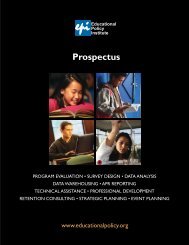A BluePrint for Success: Case Studies of Successful - Educational ...
A BluePrint for Success: Case Studies of Successful - Educational ...
A BluePrint for Success: Case Studies of Successful - Educational ...
You also want an ePaper? Increase the reach of your titles
YUMPU automatically turns print PDFs into web optimized ePapers that Google loves.
Introduction<br />
A Blueprint <strong>for</strong> <strong>Success</strong><br />
by DR. WATSON SCOTT SWAIL<br />
President & CEO, <strong>Educational</strong> Policy Institute/Project Principal Investigator<br />
In 1999, I was <strong>for</strong>tunate to direct the National Survey <strong>of</strong> Pre-College Outreach Programs <strong>for</strong> The<br />
College Board. This project resulted in a handbook and several journal articles based on the findings<br />
<strong>of</strong> our work. More than a decade later, I had the opportunity to discuss a retooling <strong>of</strong> the survey<br />
with TG. The thought was that the decade break between the two should provide new and interesting<br />
data <strong>for</strong> analysis. Through a competitive process, we were <strong>for</strong>tunate to receive funding from<br />
TG’s Public Benefits Program to conduct a new study <strong>of</strong> pre-college outreach programs. The results<br />
<strong>of</strong> this new study and the subsequent program directory can be found in the 2012 Handbook <strong>of</strong> Pre-<br />
College Outreach Programs, available on the EPI website. 1<br />
The TG-funded project included a very important second piece to be completed parallel to the survey<br />
project and using in<strong>for</strong>mation garnered from that instrument. This sub-project was to identify<br />
eight programs that showed excellent student outcomes <strong>for</strong> students, as measured by their academic<br />
improvement, high school completion, admission to college, and even their success and completion<br />
in college. Starting with 374 programs from the national survey, we were able to filter down the programs<br />
to a manageable 54. Because we were most interested in focusing on community-based programs,<br />
we excluded federally-sponsored programs, like GEAR Up and TRIO. Other programs were<br />
excluded that did not have student monitoring systems and/or data and programs that did not indicate<br />
how they evaluated student outcomes. From this group <strong>of</strong> 54, we short-listed 15 and then conducted<br />
a further screening process. In the end, we conducted 10 case studies <strong>for</strong> this project which<br />
are presented in this publication.<br />
This case study project is important <strong>for</strong> several reasons. While we were able to survey 374 programs,<br />
we also know there are literally thousands <strong>of</strong> similar programs currently in existence in the United<br />
States to help at-risk and other, less-prepared students prepare <strong>for</strong> and succeed in postsecondary education.<br />
In speaking to groups and organizations about issues <strong>of</strong> college access, a main theme in conversation<br />
is “Best Practices.” Best practices in recruitment, in academic support, in financial aid<br />
counseling, in parental involvement, in college application completion, and more. People want to<br />
know what works.<br />
1 See www.educationalpolicy.org/publications.<br />
<strong>Educational</strong> Policy Institute vi www.educationalpolicy.org




